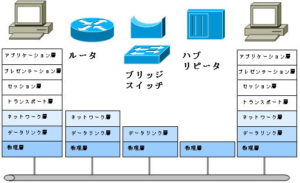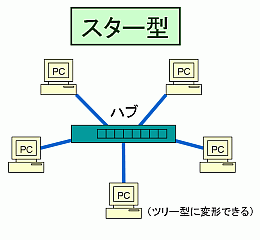Layer 2/Layer 3/Layer 1-7 devices
Layer 2 devices (bridge switches)
A hub (HUB) unconditionally copies and forwards received traffic to all ports other than the receiving port.
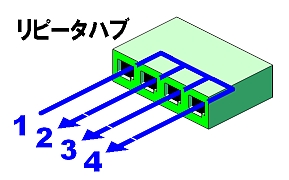
In other words, traffic will flow even to a port that does not have a communication partner. If unnecessary traffic flows like this, traffic jams are likely to occur.
This area where congestion is likely to occur, formally called a segment, is a collision domain.
As the number of hosts in a collision domain increases, the probability of collisions inevitably increases. If you send it at the wrong time, it will collide with a packet sent by a host in the same collision domain.
Network performance suffers when there are many collisions. And in the worst case, the network goes down.
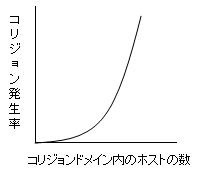
To reduce the occurrence of collisions and make better use of limited bandwidth, it is necessary to partition the collision domain.
By splitting the collision domain, you can reduce the number of hosts in the collision domain. As a result, the probability of collision can be reduced.
Bridges and switches are devices that divide this collision domain and operate at the data link layer.
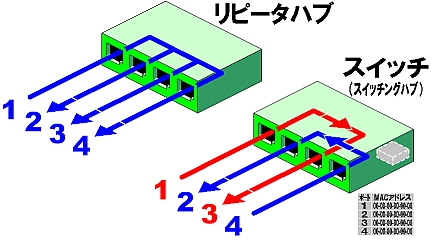
Bridges and switches manage incoming and outgoing frames in MAC address tables. So I know which device is connected to which port.
A MAC address (Media Access Control address) is a number that identifies each node on the network, and is a hardware-specific physical address written in the NIC.
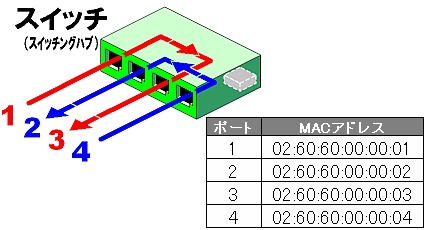
In Ethernet, the specifications include the source MAC address and the destination MAC address in the frame to be transmitted. By learning this MAC address, bridges and switches forward frames only to the port connected to the destination host and do not flow unnecessary frames to other ports, dividing the broadcast domain.
However, broadcasts whose destination is all (FF:FF:FF:FF:FF:FF) will be forwarded. You’ll need a router to keep the broadcasts off.
Split broadcast domain
Bridges and switches divide the collision domain, but forward broadcasts destined for all (FF:FF:FF:FF:FF:FF).
There are many broadcasts with the destination MAC address (FF:FF:FF:FF:FF:FF) in the network. A typical example is an ARP request. ARP is the process that happens when you want to know the MAC address of a destination computer.
The trouble with broadcasts is that every host receiving the broadcast must process this frame. Even if it’s not addressed to you, you still have to deal with it.
A router is required to control broadcasts and improve network performance. Routers block broadcasts by default.
Routers can divide broadcast domains by not streaming broadcasts.
Splitting broadcast domains can certainly improve network performance, but only for destined unicasts. Broadcast traffic flows within the broadcast domain to which it belongs. However, dividing the broadcast domain reduces the size of the broadcast domain and reduces the negative impact of broadcasting on the network.
One thing to watch out for with broadcasts is that you don’t accidentally create a loop. If you build a network in a loop, a broadcast storm will occur, and the transfer will be repeated endlessly.
Layer 3 device (router)
Determination of route
Routers are important devices that determine routes. Obtain the destination network address from the received IP packet and determine the interface for forwarding.
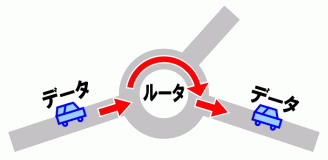
Packets to be sent reach their destination because they are delivered to the destination network by this mechanism of routers. Routers interconnect and route different networks.
Routers also provide various services. Depending on the product, it can provide connectivity to the WAN, act as a firewall by filtering packets, or act as a DHCP server.
layer 3 switch
Basically, a layer 3 switch is a device that can do almost the same thing as a router. The major difference between routers and layer 3 switches is whether routing processing is done in software or hardware.
Layer 3 switches use dedicated hardware called ASICs for part or all of the processing. Therefore, packets can be processed at high speed, unlike software that performs all processing on the CPU.
Layer 3 switches with many Ethernet ports are gaining popularity because the price of layer 3 switches has become affordable and Ethernet has become the mainstream for building networks. The unit price per port is low, and it is excellent in cost performance.
However, many Layer 3 switches are Ethernet-specific, and routers are generally more feature-rich.
Layer 1 to 7 equipment (gateway)
A gateway is a device that interconnects different protocols. Communication is possible by mutually converting data with different protocols.
The gateway recognizes all layers from layer 1 to layer 7, absorbs the difference in transmission method, and enables communication between heterogeneous devices. In general, it refers to a device that relays layer 4 (transport layer) or higher.
There are two types of gateways: dedicated hardware and software that executes the gateway service program on the OS.
Computers on your network are not just computers running Windows. There are also computers with operating systems such as UNIX, Macintosh, and NetWare. To interconnect these computers, they communicate through gateways.
Please note that the role is different from the default gateway, which is the gateway to the network.

